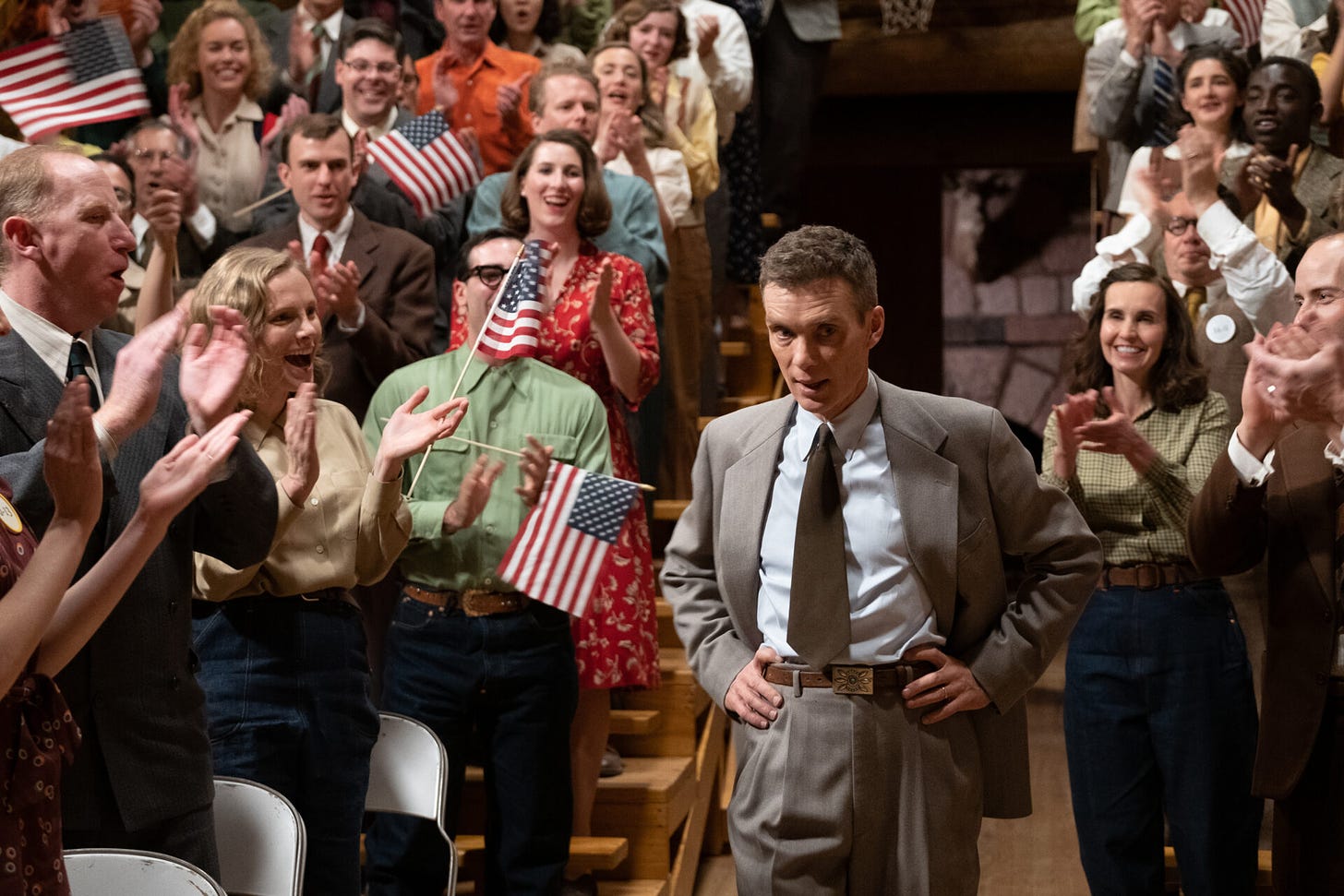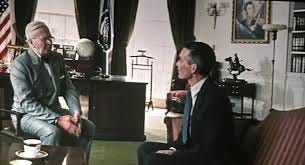Reprinted with permission from Greg Mitchell’s newsletter Oppenheimer: From Hiroshima to Hollywood.

There are hints that perhaps the very welcome media and intertube obsession with serious issues raised by Oppenheimer is drawing to a close. How else to explain that the two most cited related reports yesterday were that: 1) someone named Logan Paul, who apparently is a YouTube influencer and WWE star, walked out of the movie, claiming it was boring, all-talk, no action, “nothing happened,’“ and 2) a woman made her husband close his eyes during the Murphy-Pugh sex scene to help him overcome his addiction to porn and ease her own “betrayal trauma.”
Nevertheless, I shall carry on.
Perhaps the crucial scene in Oppenheimer arrives when the title character arrives at a large gathering of Los Alamos scientists, staffers and wives, to celebrate (there is no other word for it) the “successful” bombing of Hiroshima. Something like this actually did happen. Lately I’ve been analyzing the script by director Christopher Nolan, newly published (here is my report yesterday), so let’s see if it illuminates what we see in that key moment on the movie screen.
In the film, Kitty sends her nervous husband on his way that night and he arrives to find the crowd already whooping and hollering and stamping their feet on the bleachers. He seems a bit baffled but makes his way to the stage as the yelling only increases. Finally he grins and lifts his hands over his head in a typical symbol of triumph.
The foot stamping continues and we realize that we have heard it in the background several times already in the movie as foreshadowing (and we will notice it a few more times before the end). In the movie, as in real life, Oppenheimer goes on to quip that the Japanese are probably not too happy tonight and he only wishes the U.S. could have used his ghastly new weapon against Germany.
But then comes the really critical part. Oppenheimer starts to have a “vision,” as he tends to do in the movie. He hears a baby or a woman shriek. A white flash envelops the room. He sees, very briefly, a young white woman (as it happens, played by the director’s daughter), whose face appears deeply burned or melting. This would seem to suggest that Oppie is more concerned about future use of a bomb against America than what just happened across the globe to Japanese civilians.
A few seconds later he exits the stage shakily and steps in a blackened object – hard to tell what it is at first, but then it seems to represent a charred corpse. As he heads for the exit he sees a couple who are kissing and a man who seems to be in tears being comforted by a woman.
It’s powerful but over far too quickly (it’s a tiny part of a three-hour movie) to really absorb the images and message especially since we are then quickly onto the dramatic next scene at the White House. The only injured human in the vision is quite white and American. And there’s little else in the movie that explicitly portrays what Oppie is thinking or feeling or imagining about victims of his bomb, and why.
So how is it handled in the screenplay, as published?
Confirming its relative brevity, the let’s-celebrate-the-death-of-a-city scene comprises barely 2 1/2 pages of the 200+ in the published script.
The setting is described as the Fuller Lodge. Oppie hears the stamping feet as he enters, “like a high school pep rally.” Soon that becomes “oppressive,” causing “cacophony.” After his victory speech, however, he can no longer hear the crowd. The screenplay claims that “the thunder of a thousand storms rolls over, deafening,” but I don’t recall such an ultra-high volume effect. Then Oppenheimer sees “flesh ripped from the smiling young faces.” Well, as noted already, I believe there was just one such victim clearly shown in the film, if briefly. Did Nolan lose faith or bravery, or simply find he could not film the human effects coherently?
Then Oppenheimer sees “plasma roiling” and “the devil’s claw” – i.e. mushroom cloud – ”reach into the night sky.” Again, I might be wrong, but I don’t recall this, do you? Then he spots “piles of ashes where the young crowd was cheering.” (Ditto.) Finally he steps into “a charred corpse.” Okay, I did see that. As he walks off, a woman laughs, there’s “a hand up a sweater,” a man is crying.
Outside he spots “a young physicist” vomiting but there’s no hint why. Watching the movie, I guessed this was supposed to represent a fairly well-known claim that Robert Wilson, who had come to oppose dropping the bomb over cities, indeed got sick and threw up after a celebratory party. But I told my wife, “a lot of people will figure the man was just drunk.” Indeed, one of my other family members soon confirmed that this was his impression.
And that’s it. Quickly, too quickly, we are on to the next scene – Oppie meeting the President, for some, by the end, perhaps more memorable than the confusing scene at Fuller Lodge.

Thanks for reading Oppenheimer: From Hiroshima to Hollywood! Subscribe for free to receive new posts and support my work.
Greg Mitchell is the author of a dozen books, including “Hiroshima in America,” and the recent award-winning The Beginning or the End: How Hollywood – and America – Learned to Stop Worrying and Love the Bomb, and has directed three documentary films since 2021, including two for PBS (plus award-winning “Atomic Cover-up”). He has written widely about the atomic bomb and atomic bombings, and their aftermath, for over forty years. He writes often at Oppenheimer: From Hiroshima to Hollywood.




With regards to using nuclear weapons against Germany, that was definitely Churchill’s wish. Nuclear research and bomb theories in the UK were originally way ahead of ours. UK scientists and engineers were the first to know roughly how much U235 was needed for an explosion (a few pounds) an understanding which they gave to our nuclear scientists and engineers.
The UK simply did not have the massive industrial apparatus which we had to produce a weapon then which is at the core of “Oppenheimer”.
The need to bomb Germany evaporated when the ALSOS-team reached Paris where it found that Germany was not developing a nuclear weapon.
Just the thought of the U.S. hitting Germany “with that awful thing”, as Eisenhower described the bomb, makes my hair stand on end, and makes me profoundly angry. IF there is a G-d, why did He make the resources to create such a monstrous weapon? Why did He make men’s minds so willing to use such a monstrous weapon on other human beings. A nuclear weapon dropped on Germany would have creates h*ll on earth for the rest of Western Europe. My guess is hundreds of thousands of Europeans would have succumbed to radiation sickness. “In the beginning, G-d created the means for man (a creation in his likeness) to destroy himself and the rest of Earth”.